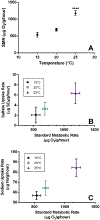It's all about the fluxes: Temperature influences ion transport and toxicity in aquatic insects
- PMID: 32014642
- PMCID: PMC12128651
- DOI: 10.1016/j.aquatox.2020.105405
It's all about the fluxes: Temperature influences ion transport and toxicity in aquatic insects
Abstract
Many freshwater ecosystems are becoming saltier and/or warmer, but our understanding of how these factors interact and affect the physiology and life history outcomes of most aquatic species remain unknown. We hypothesize that temperature modulates ion transport rates. Since ion transport is energetically expensive, increases in salinity and/or temperature may influence ion flux rates and ultimately, organismal performance. Radiotracer (22Na+, 35SO4-2, and 45Ca2+) experiments with lab-reared mayflies (N. triangulifer) and other field-collected insects showed that increasing temperature generally increased ion transport rates. For example, increasing temperature from 15 °C to 25 °C, increased 22Na+ uptake rates by two-fold (p < 0.0001) and 35SO4-2 uptake rates by four-fold (p < 0.0001) in the caddisfly, Hydropsyche sparna. Smaller changes in 22Na+ and 35SO4-2 uptake rates were observed in the mayflies, Isonychia sayi and Maccaffertium sp., suggesting species-specific differences in the thermal sensitivity of ion transport. Finally, we demonstrated that the toxicity of SO4 was influenced by temperature profoundly in a 96-h bioassay. Under the saltiest conditions (1500 mg L-1 SO4), mayfly survival was 78 % at 15 °C, but only 44 % at 25 °C (p < 0.0036). Conceivably, the energetic cost of osmoregulation in warmer, saltier environments may cause significant major ion toxicity in certain freshwater insects.
Keywords: Ion transport; Osmoregulation; Salinity; Temperature; Toxicity.
Copyright © 2020 Elsevier B.V. All rights reserved.
Conflict of interest statement
Declaration of Competing Interest The authors declare that they have no known competing financial interests or personal relationships that could have appeared to influence the work reported in this paper.
Figures




Similar articles
-
Sulfate transport kinetics and toxicity are modulated by sodium in aquatic insects.Aquat Toxicol. 2017 Sep;190:62-69. doi: 10.1016/j.aquatox.2017.06.027. Epub 2017 Jul 1. Aquat Toxicol. 2017. PMID: 28692867
-
Comparative sodium transport patterns provide clues for understanding salinity and metal responses in aquatic insects.Aquat Toxicol. 2016 Feb;171:20-9. doi: 10.1016/j.aquatox.2015.12.006. Epub 2015 Dec 17. Aquat Toxicol. 2016. PMID: 26730725
-
Physiological plasticity and acclimatory responses to salinity stress are ion-specific in the mayfly, Neocloeon triangulifer.Environ Pollut. 2021 Oct 1;286:117221. doi: 10.1016/j.envpol.2021.117221. Epub 2021 May 4. Environ Pollut. 2021. PMID: 33975217 Free PMC article.
-
Toxicological perspective on the osmoregulation and ionoregulation physiology of major ions by freshwater animals: Teleost fish, crustacea, aquatic insects, and Mollusca.Environ Toxicol Chem. 2017 Mar;36(3):576-600. doi: 10.1002/etc.3676. Epub 2016 Dec 30. Environ Toxicol Chem. 2017. PMID: 27808448 Free PMC article. Review.
-
Why are mayflies (Ephemeroptera) lost following small increases in salinity? Three conceptual osmophysiological hypotheses.Philos Trans R Soc Lond B Biol Sci. 2018 Dec 3;374(1764):20180021. doi: 10.1098/rstb.2018.0021. Philos Trans R Soc Lond B Biol Sci. 2018. PMID: 30509920 Free PMC article. Review.
Cited by
-
Voltage-gated ion channels as novel regulators of epithelial ion transport in the osmoregulatory organs of insects.Front Insect Sci. 2024 May 21;4:1385895. doi: 10.3389/finsc.2024.1385895. eCollection 2024. Front Insect Sci. 2024. PMID: 38835480 Free PMC article. Review.
-
Temperature and nutrients alter the relative importance of stochastic and deterministic processes in the coastal macroinvertebrates biodiversity assembly on long-time scales.Ecol Evol. 2024 Feb 22;14(2):e11062. doi: 10.1002/ece3.11062. eCollection 2024 Feb. Ecol Evol. 2024. PMID: 38389996 Free PMC article.
-
The cumulative impacts of anthropogenic stressors vary markedly along environmental gradients.Glob Chang Biol. 2023 Feb;29(3):590-602. doi: 10.1111/gcb.16435. Epub 2022 Sep 26. Glob Chang Biol. 2023. PMID: 36114730 Free PMC article.
-
Respirometry reveals major lineage-based differences in the energetics of osmoregulation in aquatic invertebrates.J Exp Biol. 2023 Oct 15;226(20):jeb246376. doi: 10.1242/jeb.246376. Epub 2023 Oct 31. J Exp Biol. 2023. PMID: 37767711 Free PMC article.
-
Effects of water temperature on freshwater macroinvertebrates: a systematic review.Biol Rev Camb Philos Soc. 2023 Feb;98(1):191-221. doi: 10.1111/brv.12903. Epub 2022 Sep 29. Biol Rev Camb Philos Soc. 2023. PMID: 36173002 Free PMC article.
References
-
- Bradley TJ, 2013. Saline-water insects: ecology, physiology and evolution. In: Lancaster J, Briars RA (Eds.), Aquatic Insects: Chalenges to Populations: Proceedings of the Royal Entomological Society’s 24th Symposium. Royal Entomological Society of London, Oxfordshire, pp. 20–35.
-
- Brecken-Folse JA, Mayer FL, Pedigo LE, Marking LL, 1994. Acute toxicity of 4-nitrophenol, 2,4-dinitrophenol, terbufos and trichlorfon to grass shrimp (Palaemonetes spp.) and sheepshead minnows (Cyprinodon variegatus) as affected by salinity and temperature. Environ. Toxicol. Chem 13, 67–77.
-
- Buchwalter DB, Jenkins JJ, Curtis LR, 2003. Temperature influences on water permeability and chlorpyrifos uptake in aquatic insects with differing respiratory strategies. Environ. Toxicol. Chem 22, 2806–2812. - PubMed
-
- Cairns JJ, 1986. The myth of the most sensitive species. Bioscience 36, 670–672.
MeSH terms
Substances
Grants and funding
LinkOut - more resources
Full Text Sources
Miscellaneous

